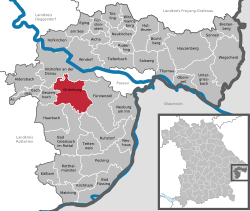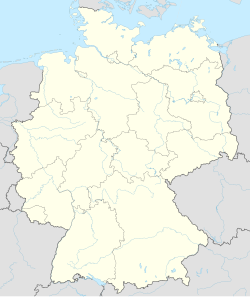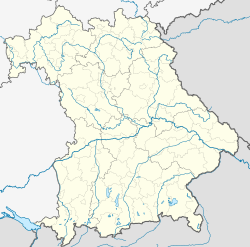Top Qs
Timeline
Chat
Perspective
Ortenburg, Bavaria
Municipality in Bavaria, Germany From Wikipedia, the free encyclopedia
Remove ads
Ortenburg (Central Bavarian: Otnbuag) is a municipality and old market town in the district of Passau in Bavaria in Germany.
You can help expand this article with text translated from the corresponding article in German. (March 2009) Click [show] for important translation instructions.
|
Remove ads
Geography
Summarize
Perspective
Geographical location
Ortenburg is situated in the forested area south of the Danube and north of the Rott. It is one of the main centres of population in the Lower Bavarian Upland. The majority of the municipality is located in the Wolfach Valley and the Wolfach itself runs directly through Ortenburg.
The market town lies 20 km west of Passau, 10 km south of Vilshofen an der Donau, 12 km northwest of Bad Griesbach and 20 km north of Pocking.
Neighbouring municipalities
The closest municipalities are Haarbach, Beutelsbach, Vilshofen an der Donau, Fürstenzell, and Bad Griesbach im Rottal.
Villages
The municipality of Ortenburg consists of the market town of Ortenburg and more than 100 villages, hamlets and isolated settlements.
The most relevant villages are Dorfbach, Göbertsham, Holzkirchen, Königbach, Neustift, Oberiglbach, Sammarei, Söldenau and Unteriglbach.
Neustift is home to the St. Scholastika monastery, which is the motherhouse of the Bavarian Province of the Benedictine Sisters of Adoration in Germany.

Sammarei (Bavarian for: St. Mary) is a Catholic place of pilgrimage. The Sammarei pilgrimage church was built by Isaak Bader and consecrated in 1631. The original chapel is still preserved behind an iconostasis-like altar wall. It contains the baroque high altar from 1772 with the miraculous image from 1631. Around the chapel there are around 1300 votive images which illustrate the importance of this place of pilgrimage. The main and side altars are merged to form a monumental five-part altar wall.
Remove ads
History
Summarize
Perspective

Set in the Wolfach River valley, Ortenburg can look back over a 900-year history. In about 1120 it was established by the Counts of Ortenburg (De). At the same time, the upwardly mobile von Kamm family appeared on the scene. However, during the thirteenth century, the von Kamms relocated to Hals (now a quarter of Passau). The Ortenburg counts, whose own origins lay with the Spanheimer dynasty, were keen to establish their own separate dynastic centre and such the Imperial County of Ortenburg kept its Imperial immediacy until 1806.
The Ortenburgs were among the most powerful of the Bavarian nobility, competing in terms of power and position with the Wittelsbach dynasty. During the height of their power, during the twelfth and thirteenth centuries, the Ortenburgs held lands from as far south as the Brixen valley, that extended also far into the Upper Palatinate.
Smuggling
Smuggling across the border Bibles (Martin Luther) to Habsburg: Hans Ungnad von Weißenwolff, Freiherr von Sonneck, Hans III (1493–1564), famous Bible printer and smuggler in Bad Urach[3] Smuggler, translator and Slovene refugee Protestant preacher Primož Trubar, who published the first books in Slovene and is regarded as the key consolidator of the Slovene identity, lived in Tübingen Derendingen. In The Free Imperial City (German: Freie Reichsstadt) bibles and the Ortenburger Ratschlag was produced.
Krypto Protestants
The original chalice in the protestant worship is still in use in Ortenburg. In this time the church of Ortemburg was the only reachable protestant church outside the border Crypto-Protestantism of Habsburg Empire.
Mostbauern
The Mostbauern of Ortenburg (orchard meadow farmers) came as grower and cellar master protestant refugees from Austria.
Remove ads
Notable residents
- Heinrich Deubel (1890–1962), Nazi SS Dachau concentration camp commandant
References
Wikiwand - on
Seamless Wikipedia browsing. On steroids.
Remove ads





